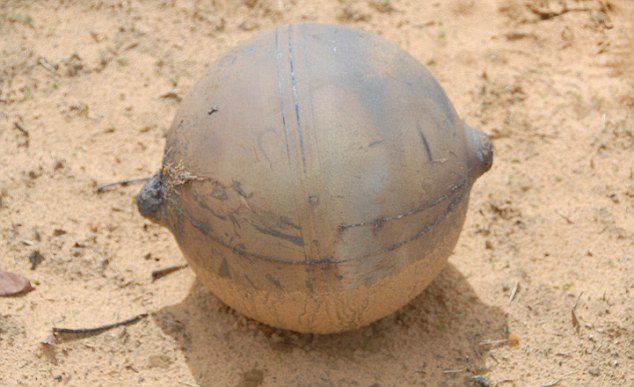
A strange metal sphere that looks like a prop from a science fiction film fell to the ground in a remote area of northern Namibia, Africa, and nobody can explain where it came from.
The metallic sphere weighs around 13 lbs, has a diameter of 14 inches and its rough surface looks like “two halves welded together”, said police forensics director Paul Ludik.
When the ball came down it caused a crater 12 inches deep and 13 ft wide, although it was found some 60f t away.
Locals claimed to have heard several explosions in the days before it was discovered by a farmer on his land.

The find sparked speculation on the internet that it could finally be proof of extra terrestrial life, even though it bore a passing resemblance to the head of a character from the children’s series Teletubbies.
Some claimed that it could be an escaped particle from the Large Hadron Collider, reindeer droppings or a Quaffle from the Harry Potter films.
Others – arguably with more accuracy – guessed it was a hydrazine tank, which are used on space satellites to store the flammable chemical.
Paul Ludik however was quick to point out that more tests need to be done and that NASA and the European Space Agency had been notified.
He said that the ball was discovered a month ago but it has only now been made public. Whilst it was made of a “sophisticated material”, it was something that was known to mankind.
Paul Ludik explained that the explosion heard by locals could have been the sonic boom when it broke the sound barrier coming down to Earth, or by the impact on the ground.
The compound appeared to be a “metallic compound normally used in space vehicles”, although he would not be surprised it it was actually from a normal aircraft.
Police deputy inspector general Vilho Hifindaka added that the sphere, which landed 480 miles from the Namibian capital Windhoek, did not pose any danger.
Vilho Hifindaka said: “It is not an explosive device, but rather hollow, but we had to investigate all this first”.
Earlier this year Britain and the rest of the world was put on alert when one of NASA’s satellites broke up and crashed to Earth.
Huge chunks of titanium up to 350lbs from car-sized Upper Atmosphere Research Satellite tore through the atmosphere at 1,800 mph but the best NASA could guess was that they landed somewhere south of Inverness on the equator.
To try and reassure the public it also revealed that the odds of being hit were one in 3,200 – more likely than getting a hole-in-one in golf.
Weeks later Germany’s Roentgen satellite crashed to Earth and split up into 30 huge chunks including one which weighed 880 lbs.